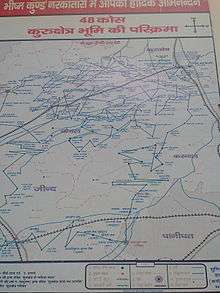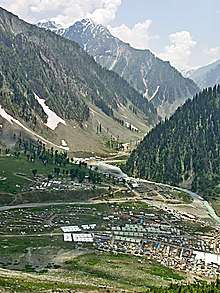Yatra
Yātrā (Sanskrit: यात्रा, 'journey', 'procession'), in Hinduism and other Indian religions, generally means a pilgrimage to holy places such as confluences of sacred rivers, places associated with Hindu epics such as the Mahabharata and Ramayana, and other sacred pilgrimage sites.[1] Tīrtha-yātrā refers to a pilgrimage to a holy site and is generally undertaken in groups. One who goes on a yatra is known as a yatri. As per Vedic Hindu Dharma Shastras, a Yatri is supposed to do Yatra barefoot. He/she should travel without umbrellas, vehicles etc., to get the benefit of the Yatra. At present these rules are not followed by many pilgrims.
Description
The journey itself is as important as the destination, and the hardships of travel serve as an act of devotion in themselves.[2] Visiting a sacred place is believed by the pilgrim to purify the self and bring one closer to the divine.[3]
In present times, yatras are highly organized affairs, with specialized tourism companies catering to the need of yatris. State governments are sometimes involved in the organization of annual yatras, stipulating numbers, registering yatris, and regulating yatri traffic.[4][5] The Hindu sacred month of Shravan is also the time of the annual Kanwar Yatra, the annual pilgrimage of devotees of Shiva, known as Kanwaria make to Hindu pilgrimage places of Haridwar, Gaumukh and Gangotri in Uttarakhand to fetch holy waters of Ganges River, way back in 2003, 55 lakh pilgrims reach Haridwar.[6] Other important Tirtha pilgrimages are Char Dham Yatra, which involves Badrinath, Kedarnath, Gangotri, and Yamunotri; Amarnath yatra in Jammu and Kashmir.
Other meanings
'Yatra' can also describe a procession, or any festival which figures a procession, such as Rath Yatra, where chariots are pulled in parade down the streets of Puri in Orissa. In modern times the word can be used to denote marches or demonstrations, for political, environmental or societal causes.[7][8][9]
Famous yatras
48 kos parikrama of Kurukshetra

48 kos parikrama of Kurukshetra, phrase meaning a 48 kos circumambulation parikrama (pilgrimage) of various Mahabharata-related and other vedic era tirthas (Hindu sacred sites), around the holy city of Kurukshetra in the state of Haryana, India.[10][11][12][13] Within Kurukshetra, along with Brahma Sarovar, other important sites are Jyotisar (place of "Gitaupadesha" - the first Upadeśa or discourse of Bhagavad Gita by Lord Krishna)[14][15] and Sannihit Sarovar (Hindu genealogy registers of Kurukshetra are kept here).[16] Since this is a site associated with the vedic era Lord Krishna and mahabharata, it is an important place of pilgrimage for Hindus. It is one of 3 main pilgrimage sites related to "Krishna" circuit, namely "48 kos parikrama of Kurukshetra" in Haryana, "Braj parikarma" in Mathura in Uttar Pradesh state and "Dwarka parkarma" (Dwarkadish yatra) at Dwarkadhish Temple in Gujarat state.
kurukshetra is of religious significance to Hindus, Buddhists, Jains, and Sikhs.
84 Kosi parikrama
The 84-Kosi Yatra is a tradition in Hindu religion that has been there for thousands of years with the belief that it gives deliverance to the performer from the cycle of 84-Lakh Yonis (the cycle of birth and death). According to Hindu belief, the king of Ayodhya performed the "yagna" in the "treta period" at a place in Makhurha in Basti district of Uttar Pradesh which included circumnavigating the six districts in the region. Some religious leaders believe that the right place to start the parikrama should be Basti instead of Ayodhya. According to some, the dates for 84-Kosi Yatra are fixed and takes place in the month of Chaitra.
Amarnath Yatra

The Amarnath Temple in Jammu and Kashmir is dedicated to Shiva, one of the trinity of gods. The temple is on Amarnath Peak, and is among the most famous shrines in Hinduism. Every year inside the main Amarnath cave an ice Shiva lingam forms, along with two other ice formations representing Ganesha and Parvati. Amarnath yatra is held every year to pay homage to Shiva and Parvati. The temple is a very popular yatra destination for Hindus; about four lakh people visit during the season.
Brij Yatra
Vraja Parikrama circuit of pilgrimage was formally established by the 16th century sadhus of vaishnava sampradaya with fixed routes, itinerary and rituals. The circuit covers is spread across 2500 sqkm area with 84 kos or 300 km long periphery extending 10 km to east and 50 km to north and west. Braj has two main types of pilgrimage circuits, the traditional longer "Braj Yatra" encompassing the whole circuit, and the other shorter significantly modified contemporary point-to-point pilgrimage to visit the main sites at Mathura, Vrindavan, Gokul, Govardhan. The former, longer traditional pilgrimage route, also includes additional sacred sites Nandgaon and Barsana with travel on foot..[17]
Char Dham Yatra
The Chardham belongs to four pilgrimage places in India; they are Badrinath, Dwarka, Jagannath Puri, and Rameshwaram. The Char Dham is often considered the most revered sites for Hindus that have to be visited in one's lifetime. There is a Chota Char Dham as well includes Yamunotri, Gangotri, Badrinath, and Kedarnath situated in Garhwal Himalayas.
Deoghar Yatra
Deoghar means abode of the gods and goddesses. It is also known as Baidyanath Dham or Baba Dham situated on the eastern side of Jharkhand. It is an important Hindu pilgrimage center having Baidyanath Temple one of the twelve Lord Shiva Jyothirlingams in India. The pilgrims carry the holy water of holy river Ganges from Sultanganj's and offered to the Jyotirlingam of Shiva at Deoghar. These pilgrims called Kanwariya, reciting Bol Bam on the way of walk 109 KM, The march of Kanwariya start during the holy month of Shravan the wet season each year in India. Shravani Mela is the most celebrated 30-day festival in Baidyanath Temple Temple of Jharkhand.
Kailash-Mansarovar Yatra
Mansarovar is a fresh-water lake in Tibet near Mount Kailash, and both are places of pilgrimage attracting religious people from India and neighboring countries. The mountain is considered a sacred place in four religions: Hinduism, Buddhism, Jainism, and Bon. According to Hindu mythology mount Kailash is the abode of Shiva and circumambulating Mount Kailash on foot is a holy ritual. Another lake called Lake Rakshastal lying close to the west of Lake Manasarovar and The Great Mount Kailash. These lakes are the source of the Brahmaputra River and the Karnali River, a tributary of the river Ganges.
Kanwar Yatra
The Kanwar Yatra is an annual pilgrimage of devotees of Shiva, known as Kānwarias, to Hindu pilgrimage places of Haridwar, Gaumukh and Gangotri in Uttarakhand and Sultanganj in Bihar to fetch holy waters of Ganges River. Millions of participants gather sacred water from the Ganga and carry it across hundreds of miles to dispense as offerings in their local Śhiva shrines, or specific temples such as Pura Mahadeva and Augharnath temple in Meerut, and Kashi Vishwanath, Baidyanath, and Deoghar in Jharkhand.[18]
Kasi yatra
At Kashi Yatra, it is customary for every Hindu to undergo Kasi yatra on barefoot. Pilgrims also visit Gaya to do Gaya Shraddha to their ancestors. Details regarding how to perform various rituals, the greatness of Kashi Kshetra.[19] Importance of Kasi yatra is said in Kasi-Khand of Skanda Purana.
Pandharpur yatra of Maharashtra
Pandharpur yatra is one of the most popular festivals in India. The annual yatra to the famous Vithoba temple at Pandharpur is held every year during the month of June and July. Thousands of pilgrims come to Pandharpur carrying litters with the images of Jñāneśvar from Alandi, Tukaram from Dehu, Eknath from Paithan, and Nivruttinath from Trimbakeshwar. These pilgrims are referred to as Varkaris.
Ratha Yatra
Among the Ratha Yatra at various sacred sites, the most popular one is Jagannath Rath jatra at Puri in Odisha. Other popular Rath Yatras are Dhamrai Jagannath Roth, Rathayatra of Mahesh, Manipur Ratha Yatra in Manipur which was started in 19th century and ISKON Ratha Yatra in more than 100 places across the world.
The Festival of Chariots of Jagannatha is held every year at Puri in the state of Orissa. The ten-day ratha yatra commemorates Lord Jagannath's annual visit to Gundicha Mata's temple a short distance away. Thousands of pilgrims come to Puri during the festival with a desire to help pull Jagannath's chariot with ropes. This is the only day when devotees who are normally not allowed in the temple premises, such as non-Hindus and foreigners, can get their glimpse of the deities.
Gallery
 Amarnath Yatra Camp.
Amarnath Yatra Camp. Buddha Amarnath Yatra procession, Poonch
Buddha Amarnath Yatra procession, Poonch
See also
- Hindu pilgrimage sites in India
- List of Hindu festivals
- Padayatra
- Tirtha
- Tirtha and Kshetra
References
- Juergensmeyer, Mark (2006). The Oxford Handbook of Global Religions. U.S.: Oxford University Press. ISBN 0-19-513798-1.
- Fowler, Jeaneane D. (1997). "Yatra: Pilgrimage". Hinduism: Beliefs and Practices. Sussex Academic Press. ISBN 1-898723-60-5.
- Timothy, Dallen J.; Daniel H. Olsen (2006). Tourism, Religion and Spiritual Journeys. Routledge. ISBN 0-415-35445-5.
- "Amarnath Yatra". Office of Divisional Commissioner, Jammu and Kashmir Government. Archived from the original on 2007-10-19.
- Singh Ahluwalia, Manjit. "Holy Chhari or Manimahesh Yatra". Social, Cultural and Economic History of Himachal Pradesh. Indus Publishing. ISBN 81-7387-089-6.
- "SPOTLIGHT: The long walk for worship". Frontline, (The Hindu). August 14–27, 2004. Archived from the original on 2010-08-06.
- "Jal Adhikar Yatra Takes Off". The South Asian. September 10, 2006.
- "'Save Noyyal Yatra' draws good crowd". The Hindu Business Line. October 3, 2005. Archived from the original on 2009-06-07. Retrieved 2008-02-26.
- "India's rally for Right to Education - Shiksha Adhikar Yatra". Global Call to Action Against Poverty. July 3, 2007. Archived from the original on July 19, 2008.
- "Kurukshetra map". kurukshetra.nic.in. Archived from the original on 25 June 2016. Retrieved 24 July 2016.
- "Haryana Tourism". Retrieved 24 July 2016.
- "Development of all pilgrimage sites located within a radius of 48 kos (miles) of Kurukshetra would be carried out". Chief Minister's Office, Haryana. 11 October 2015. Retrieved 24 July 2016.
- "The 48 Kos Kurukshetra Region". harekrsna.com. Retrieved 24 July 2016.
- Jyotisar Kurukshetra district website.
- "Jyotisar". Haryana Tourism Corporation Limited. Retrieved 2014-08-08.
- "Tirath in Kurukshetra - Sannehit Sarovar". Kurukshetra district website. Retrieved 2014-08-08.
- Janet Cochrane, 2008, Asian Tourism: Growth and Change, page 249.
- Singh, Vikash (2017). Uprising of the Fools. Stanford University Press.
- "Kumbh Mela Diaries: Varanasi".
External links
| Wikimedia Commons has media related to Amarnath Yatra. |
